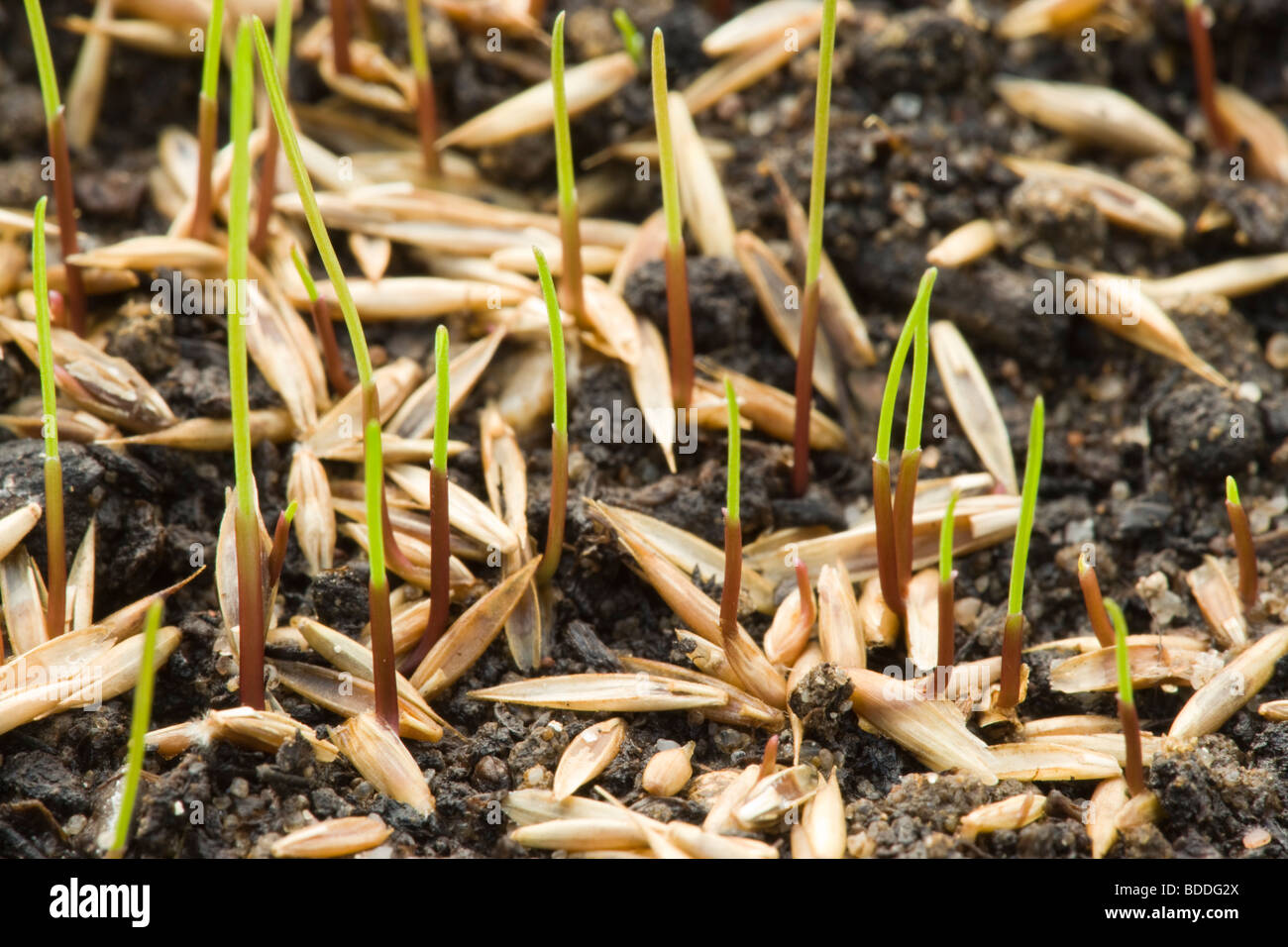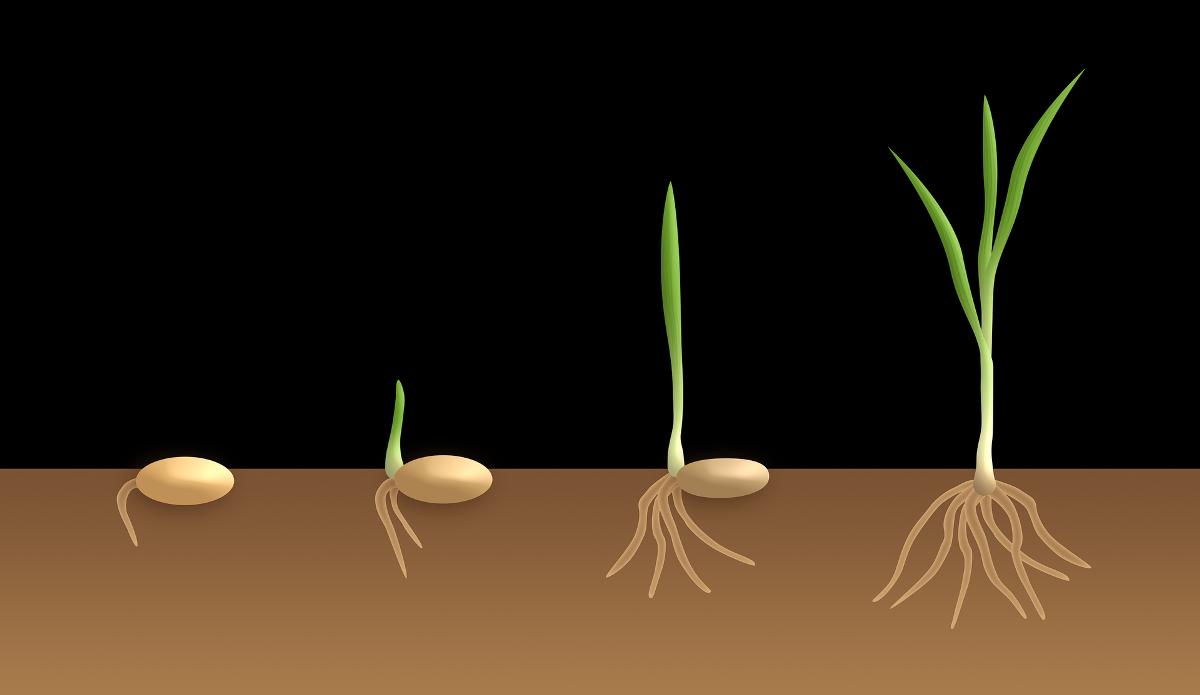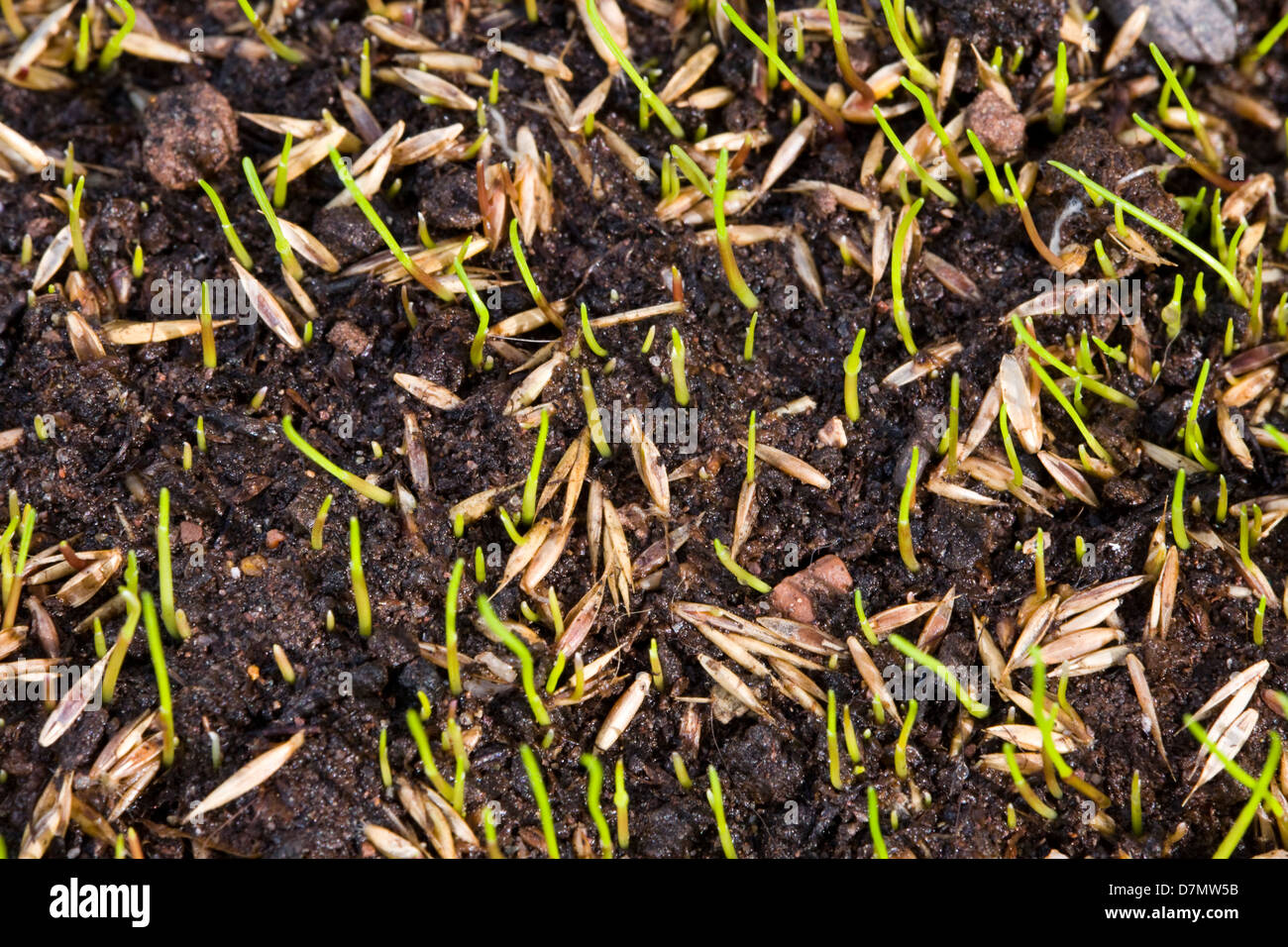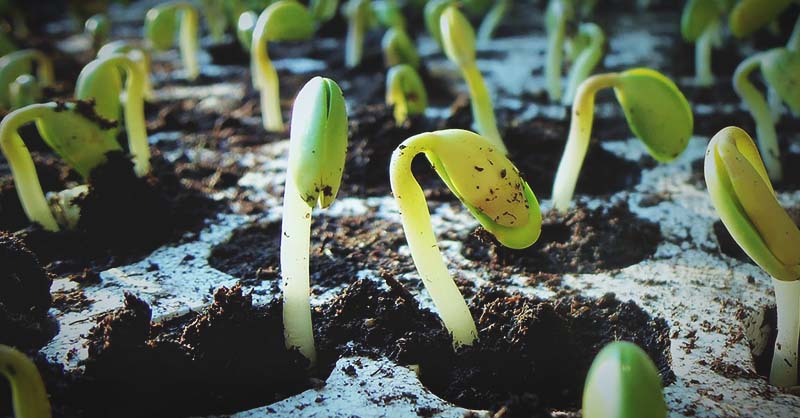Understanding the Grass Germination Process
Grass germination is a complex process that involves the transformation of a seed into a seedling. It is a critical stage in the life cycle of grass, and understanding the factors that affect it can help you optimize the conditions for healthy growth. The germination process typically begins when a seed is exposed to water, which triggers a series of physiological changes that ultimately lead to the emergence of a seedling.
The length of time it takes for grass to germinate can vary depending on several factors, including the type of grass, soil temperature, moisture, and light. Generally, grass seeds can take anywhere from 3 to 28 days to germinate, with some species germinating faster than others. For example, perennial ryegrass can germinate in as little as 3 to 5 days, while tall fescue can take up to 14 days.
Soil temperature is a critical factor in grass germination, with most grass species requiring a temperature range of 50°F to 90°F (10°C to 32°C) to germinate. Moisture is also essential, as seeds need consistent moisture to break dormancy and begin the germination process. Light is also important, as most grass species require adequate light to undergo photosynthesis and support growth.
Understanding the grass germination process can help you identify potential issues that may affect the health and growth of your lawn. By recognizing the signs of germination, such as the emergence of the radicle (primary root) and the cotyledon (seed leaf), you can take steps to optimize the conditions for healthy growth and development.
Whether you’re a seasoned gardener or a novice lawn owner, understanding how long it takes grass to germinate can help you make informed decisions about lawn care and maintenance. By providing the right conditions for germination, you can give your grass the best possible start and set it up for a lifetime of healthy growth and development.
Factors Affecting Grass Germination Time
Several factors can influence the time it takes for grass to germinate, including soil type, temperature, watering, and sunlight. Understanding these factors can help you optimize the conditions for faster germination and healthier growth.
Soil type is a critical factor in grass germination, as different soils have varying levels of nutrients, water-holding capacity, and aeration. For example, clay soils tend to retain more water than sandy soils, which can affect the germination rate. Similarly, soils with high levels of organic matter tend to support faster germination.
Soil temperature is another important factor, as most grass species require a specific temperature range to germinate. For example, cool-season grasses such as Kentucky bluegrass and perennial ryegrass germinate best in temperatures between 50°F and 75°F (10°C and 24°C), while warm-season grasses such as Bermudagrass and zoysiagrass germinate best in temperatures between 75°F and 90°F (24°C and 32°C).
Watering is also crucial, as grass seeds need consistent moisture to break dormancy and begin the germination process. However, overwatering can be detrimental, as it can lead to rot and poor germination. Aim to provide about 1-2 inches of water per week, either through rainfall or irrigation.
Sunlight is also essential for grass germination, as most grass species require adequate light to undergo photosynthesis and support growth. However, excessive sunlight can be detrimental, especially in warmer climates. Aim to provide partial shade, especially during the hottest part of the day.
Other factors that can affect grass germination time include the quality of the seed, the depth of sowing, and the presence of pests or diseases. Using high-quality seed, sowing at the correct depth, and controlling pests and diseases can all help to optimize the germination process.
By understanding the factors that affect grass germination time, you can take steps to optimize the conditions for faster germination and healthier growth. This can help you to achieve a lush, green lawn that is resistant to pests and diseases.
When it comes to how long it takes grass to germinate, the answer can vary depending on the specific factors mentioned above. However, by providing the right conditions, you can give your grass the best possible start and set it up for a lifetime of healthy growth and development.
The Role of Soil Temperature in Grass Germination
Soil temperature plays a crucial role in grass germination, as it affects the rate and success of the germination process. Different types of grass have optimal temperature ranges for germination, and understanding these ranges can help you optimize the conditions for healthy growth.
Cool-season grasses, such as Kentucky bluegrass and perennial ryegrass, germinate best in soil temperatures between 50°F and 75°F (10°C and 24°C). These grasses thrive in temperate climates with moderate temperatures and adequate moisture. On the other hand, warm-season grasses, such as Bermudagrass and zoysiagrass, germinate best in soil temperatures between 75°F and 90°F (24°C and 32°C). These grasses are more tolerant of high temperatures and drought.
To measure soil temperature, you can use a soil thermometer or a digital thermometer. Take readings at different depths, such as 2-4 inches and 6-8 inches, to get an accurate reading. You can also use online resources, such as soil temperature maps, to determine the average soil temperature in your area.
Adjusting soil temperature can be challenging, but there are a few strategies you can use to optimize the conditions for germination. For example, you can use mulch or other soil covers to retain heat or cool the soil, depending on the temperature requirements of your grass species. You can also use irrigation systems to maintain optimal soil moisture levels.
Understanding the role of soil temperature in grass germination can help you answer the question of how long it takes grass to germinate. By providing the optimal temperature range for your grass species, you can give your grass the best possible start and set it up for a lifetime of healthy growth and development.
In addition to soil temperature, other factors such as soil moisture, light, and nutrients also play a crucial role in grass germination. By optimizing these factors, you can create an ideal environment for germination and set your grass up for success.
By taking the time to understand the role of soil temperature in grass germination, you can make informed decisions about lawn care and maintenance. This can help you to achieve a lush, green lawn that is resistant to pests and diseases.
How to Create an Ideal Environment for Grass Germination
Creating an ideal environment for grass germination is crucial for successful growth and development. By preparing the soil, selecting the right grass species, and providing adequate moisture and light, you can give your grass the best possible start.
Preparing the soil is the first step in creating an ideal environment for grass germination. This involves testing the soil pH and nutrient levels, and making adjustments as necessary. Most grass species prefer a slightly acidic to neutral soil pH, ranging from 6.0 to 7.0. You can also add organic matter such as compost or manure to improve soil structure and fertility.
Selecting the right grass species is also important for creating an ideal environment for germination. Different grass species have different requirements for temperature, moisture, and light, so it’s essential to choose a species that is well-suited to your climate and soil conditions. Cool-season grasses such as Kentucky bluegrass and perennial ryegrass are ideal for temperate climates with moderate temperatures and adequate moisture, while warm-season grasses such as Bermudagrass and zoysiagrass are better suited to warmer climates with high temperatures and drought.
Providing adequate moisture is also crucial for grass germination. Most grass species require consistent moisture during the germination process, especially during the first few weeks after sowing. You can use irrigation systems or manual watering to provide the necessary moisture, but be careful not to overwater, as this can lead to poor germination and root rot.
Light is also essential for grass germination, as most grass species require adequate light to undergo photosynthesis and support growth. However, excessive light can be detrimental, especially in warmer climates. You can use shade cloth or other shading materials to provide partial shade, especially during the hottest part of the day.
By creating an ideal environment for grass germination, you can optimize the conditions for healthy growth and development. This can help you to achieve a lush, green lawn that is resistant to pests and diseases, and requires minimal maintenance.
Understanding how to create an ideal environment for grass germination can also help you to answer the question of how long it takes grass to germinate. By providing the optimal conditions for germination, you can give your grass the best possible start and set it up for a lifetime of healthy growth and development.
Grass Germination Times: What to Expect
Grass germination times can vary depending on several factors, including the type of grass, soil temperature, moisture, and light. Understanding the typical germination times for different types of grass can help you plan and prepare for the growth of your lawn.
Cool-season grasses, such as Kentucky bluegrass and perennial ryegrass, typically germinate within 7-14 days. These grasses thrive in temperate climates with moderate temperatures and adequate moisture. Warm-season grasses, such as Bermudagrass and zoysiagrass, typically germinate within 10-21 days. These grasses are more tolerant of high temperatures and drought.
Factors that can influence germination times include soil temperature, moisture, and light. Soil temperature is one of the most critical factors, as most grass species require a specific temperature range to germinate. Moisture is also essential, as grass seeds need consistent moisture to break dormancy and begin the germination process. Light is also important, as most grass species require adequate light to undergo photosynthesis and support growth.
Understanding the typical germination times for different types of grass can help you adjust your expectations and plan accordingly. For example, if you’re planting a cool-season grass, you can expect germination to occur within 7-14 days. If you’re planting a warm-season grass, you can expect germination to occur within 10-21 days.
It’s also important to note that germination times can vary depending on the specific growing conditions. For example, if the soil is too cold or too hot, germination may be delayed. If the soil is too dry or too wet, germination may be affected.
By understanding the typical germination times for different types of grass, you can better plan and prepare for the growth of your lawn. This can help you to achieve a lush, green lawn that is resistant to pests and diseases, and requires minimal maintenance.
When it comes to how long it takes grass to germinate, the answer can vary depending on the specific factors mentioned above. However, by providing the optimal conditions for germination, you can give your grass the best possible start and set it up for a lifetime of healthy growth and development.
Troubleshooting Common Grass Germination Issues
Despite optimal growing conditions, grass germination can sometimes be affected by various issues. Understanding the common problems that can arise and knowing how to troubleshoot them can help you overcome these challenges and achieve successful germination.
Poor soil quality is one of the most common issues that can affect grass germination. Soil that is too dense, too dry, or too wet can prevent seeds from germinating properly. To address this issue, you can test your soil to determine its pH level and nutrient content. Based on the results, you can add amendments such as fertilizers or organic matter to improve soil quality.
Inadequate moisture is another common issue that can affect grass germination. Seeds need consistent moisture to break dormancy and begin the germination process. If the soil is too dry, seeds may not germinate properly. To address this issue, you can ensure that the soil is consistently moist during the germination period. You can also use mulch or other soil covers to retain moisture and reduce evaporation.
Pests or diseases can also affect grass germination. Common pests that can affect grass germination include insects, slugs, and snails. Diseases such as fungal infections or bacterial diseases can also affect germination. To address these issues, you can use integrated pest management (IPM) techniques such as crop rotation, biological control, and chemical control.
Other issues that can affect grass germination include inadequate light, extreme temperatures, and poor seed quality. To address these issues, you can ensure that the soil receives adequate light, maintain optimal temperatures, and use high-quality seeds.
By understanding the common issues that can affect grass germination and knowing how to troubleshoot them, you can overcome these challenges and achieve successful germination. This can help you to answer the question of how long it takes grass to germinate and ensure that your grass gets the best possible start.
Remember, grass germination is a complex process that involves many factors. By understanding these factors and taking steps to optimize them, you can achieve successful germination and grow a healthy, lush lawn.
How to Care for Your Newly Germinated Grass
Caring for your newly germinated grass is crucial for its growth and development. Proper care during the early stages of growth can help your grass establish a strong root system, promote healthy growth, and prevent common problems such as pests and diseases.
Watering is one of the most critical aspects of caring for newly germinated grass. It’s essential to keep the soil consistently moist during the first few weeks after germination. However, overwatering can be detrimental, so make sure to check the soil moisture regularly and adjust your watering schedule accordingly.
Mowing is another important aspect of caring for newly germinated grass. It’s essential to maintain your mower at a height of 2.5-3 inches to promote healthy growth and prevent weed growth. You should also avoid mowing your grass too frequently, as this can stress the grass and make it more susceptible to pests and diseases.
Fertilizing is also crucial for newly germinated grass. You should apply a starter fertilizer that is high in phosphorus (P) to promote root growth and development. You can also apply a balanced fertilizer that is high in nitrogen (N), phosphorus (P), and potassium (K) to promote healthy growth and development.
Other important aspects of caring for newly germinated grass include controlling weeds, pests, and diseases. You can use herbicides, insecticides, and fungicides to control weeds, pests, and diseases, but make sure to follow the instructions carefully and take necessary precautions to avoid harming your grass.
By following these tips and advice, you can provide your newly germinated grass with the best possible start and promote healthy growth and development. This can help you to answer the question of how long it takes grass to germinate and ensure that your grass gets the best possible start.
Remember, caring for newly germinated grass requires patience, attention to detail, and a commitment to providing the best possible conditions for growth and development. By following these tips and advice, you can help your grass establish a strong root system, promote healthy growth, and prevent common problems such as pests and diseases.
Conclusion: Giving Your Grass the Best Start
Understanding the grass germination process is crucial for giving your grass the best possible start. By understanding the factors that affect germination, such as soil temperature, moisture, and light, you can create an ideal environment for your grass to grow. Additionally, by troubleshooting common issues that can affect germination, such as poor soil quality, inadequate moisture, and pests or diseases, you can overcome these challenges and promote healthy growth.
By following the tips and advice provided in this article, you can give your grass the best possible start and promote healthy growth and development. Remember, grass germination is a complex process that requires patience, attention to detail, and a commitment to providing the best possible conditions for growth and development.
By understanding how long it takes grass to germinate, you can plan and prepare for the growth of your lawn. Whether you’re a seasoned gardener or a novice lawn owner, this article has provided you with the knowledge and tools you need to give your grass the best possible start.
In conclusion, giving your grass the best possible start requires a deep understanding of the grass germination process. By creating an ideal environment, troubleshooting common issues, and providing proper care, you can promote healthy growth and development and achieve a lush, green lawn that you can enjoy for years to come.
Remember, the key to successful grass germination is to provide the right conditions for growth and development. By following the tips and advice provided in this article, you can give your grass the best possible start and promote healthy growth and development.






